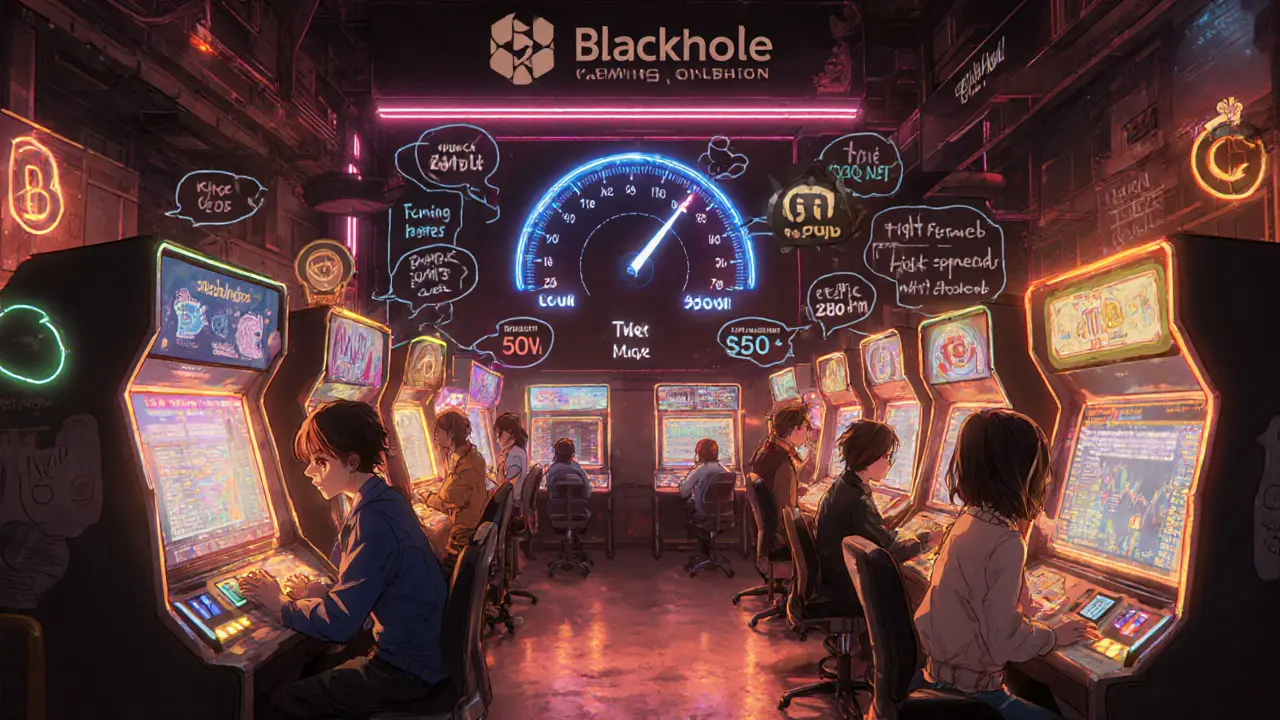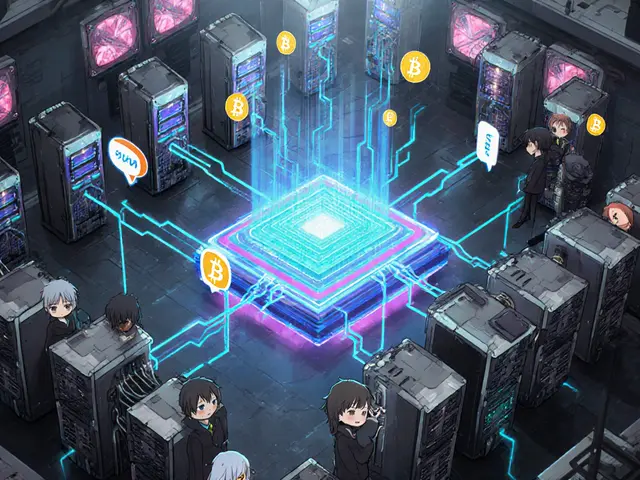Blackhole (CLMM) Tokenomics Calculator
Input Parameters
Tokenomics Overview
- Native Token: $BLACK
- Governance Model: ve(3,3)
- Voting NFT Types: Singularity & Supermassive
- Lock Periods: Up to 4 Years
- Emission Growth: +3% per epoch
VeNFT Types
- Singularity veNFTs: Lock for up to 4 years. Voting power decays over time.
- Supermassive veNFTs: Permanently burn $BLACK. Non-decaying voting power + 10% rebase bonus.
Calculation Results
Enter values and click "Calculate Earnings & Voting Power" to see your potential earnings and voting power.
Looking for a fresh take on decentralized trading? This Blackhole exchange review breaks down everything you need to know about Blackhole (CLMM), the Avalanche‑based DEX that’s turning heads with its community‑owned model and quirky tokenomics.
What Is Blackhole (CLMM)?
Blackhole is a decentralized cryptocurrency exchange (DEX) built on the Avalanche C‑Chain, launched in 2024. It was co‑founded by crypto personalities Alex Becker and Ellio Trades, who positioned the platform as a 100% community‑owned protocol.
The exchange runs a Constant‑Product Liquidity‑Mining Market Maker (CLMM) engine that aims to deliver deep liquidity with low slippage. As of October 2025, Blackhole lists roughly 40‑plus coins and over 60 trading pairs, depending on the data source.
Core Tokenomics: The ve(3,3) Model and $BLACK
The heart of Blackhole’s economics is its ve(3,3) tokenomics model. It blends the classic ve‑token approach (vote‑escrowed tokens) with a 3‑3 incentive framework that rewards liquidity providers (LPs) and governance participants simultaneously.
The native token, $BLACK, serves four purposes:
- Emission rewards for LPs.
- Collateral for minting veNFTs, which grant voting power.
- Staking to capture a slice of protocol revenue and external bribes.
- Permanent burning to create Supermassive veNFTs with non‑decaying voting power.
Emission rates increase by roughly 3% each epoch, meaning rewards adapt upward as the platform scales. This dynamic approach aims to keep incentives attractive even when market conditions shift.

Governance: Singularity vs. Supermassive veNFTs
Blackhole’s two‑tier governance revolves around Singularity veNFTs and Supermassive veNFTs. Both are minted by locking $BLACK, but they differ in lock duration and reward structure:
- Singularity veNFTs: Users lock $BLACK for up to four years. The longer the lock, the higher the veBLACK balance and voting weight. Rewards are proportional to the lock period and the amount of veBLACK held.
- Supermassive veNFTs: Created by permanently burning $BLACK. These NFTs enjoy a 10% rebase bonus and a non‑decaying voting power, making them attractive for long‑term holders who prefer a set‑and‑forget stance.
Both NFT types vote on gauge allocations, borrower selections, and protocol upgrades. The dual system gives users flexibility-either a flexible, time‑bounded commitment or a permanent, high‑impact stake.
Performance Metrics: TVL, Volume, and Fees
Metrics are the litmus test for any DEX, and Blackhole’s numbers are impressive for a platform less than two years old. According to DefiLlama, the protocol holds about $47.66million in Total Value Locked (TVL) on Avalanche. Trading activity has surged, with recent figures showing:
- 24‑hour DEX volume: $68.44million
- 7‑day volume: $185.01million
- 30‑day volume: $191.96million
- Cumulative DEX volume: $260.4million
Fee generation mirrors volume, delivering roughly $43,078 in fees over the past 24hours and a cumulative $152,770 to date. Annualized fee and revenue projections hover around $1.34million, placing Blackhole in the 83rd percentile for both volume and order‑book activity on Avalanche.
The average bid‑ask spread sits at a tight 0.611%, indicating healthy liquidity depth and competitive pricing for traders.
User Experience: Earnings, Learning Curve, and Community Support
From a user’s perspective, the platform offers three primary earning routes:
- Providing liquidity to CLMM pools and harvesting $BLACK emissions.
- Locking $BLACK into Singularity veNFTs for voting rewards and protocol revenue shares.
- Burning $BLACK to mint Supermassive veNFTs, which capture elevated bribes and rebase bonuses.
Community testimonials highlight modest but steady daily returns-often described as “pennies per day” for modest capital deployments. While the APRs can outpace many airdrop‑centric farms, newcomers frequently cite the ve(3,3) model and NFT governance as the steepest parts of the onboarding curve.
Fortunately, the ecosystem is rich in educational resources. The founders maintain an active presence on YouTube, breaking down lock‑up mechanics and gauge voting. Community‑driven guides on Discord and Reddit further demystify the process, making self‑service support viable for most users.

How Blackhole Stacks Up Against Other Avalanche DEXs
| Protocol | TVL (USD) | 24h Volume (USD) | Avg. Spread | Governance Model |
|---|---|---|---|---|
| Blackhole | 47.66M | 68.44M | 0.611% | Dual veNFT (Singularity & Supermassive) |
| Trader Joe | 120M | 85M | 0.73% | Single‑token voting (JOE) |
| Benqi | 95M | 40M | 0.81% | Token‑based governance (QI) |
Blackhole lags behind Trader Joe in total TVL but punches above its weight in fee efficiency and spread tightness. Its unique governance-especially the permanent Supermassive NFTs-offers a level of voter commitment not found on the other two platforms.
Pros, Cons, and Bottom Line
Pros
- Community‑owned: all team tokens burned into Supermassive veNFTs, eliminating sell‑pressure risk.
- Dynamic emissions: 3% growth each epoch keeps incentives fresh.
- Tight spreads and solid liquidity depth for most major pairs.
- Two‑tier governance lets users choose between flexibility and permanent influence.
Cons
- Steep learning curve around veNFT creation, lock periods, and gauge voting.
- Limited cross‑chain support; currently confined to Avalanche C‑Chain.
- Relatively low TVL compared to long‑established Avalanche DEXs.
Overall, Blackhole offers a compelling blend of innovative tokenomics and community control. If you’re comfortable navigating ve(3,3) mechanics, the platform can deliver competitive yields and a genuine voice in protocol decisions. For risk‑averse newcomers, starting with a modest $BLACK stake in a Singularity veNFT is a pragmatic entry point.
Frequently Asked Questions
What is the main difference between Singularity and Supermassive veNFTs?
Singularity veNFTs require locking $BLACK for up to four years, yielding voting power that decays as the lock expires. Supermassive veNFTs are created by permanently burning $BLACK, granting non‑decaying voting power and a 10% rebase bonus, making them ideal for users who want a set‑and‑forget stake.
Can I trade on Blackhole without locking $BLACK?
Yes. The DEX lets you swap any listed token without any lock‑up. However, you won’t earn emissions or governance rewards unless you participate in the veNFT system.
How are emissions calculated and distributed?
Emissions increase by about 3% each epoch. The total emission pool is split among liquidity providers based on their share of each pool and further boosted for veBLACK holders according to their voting weight.
Is Blackhole safe to use?
The protocol’s code is open source and has undergone multiple audits. As with any DeFi platform, risks remain-smart‑contract bugs, market volatility, and impermanent loss-so only allocate capital you can afford to lose.
Will Blackhole expand to other blockchains?
Future road‑maps hint at cross‑chain bridges, but no official launch date has been announced yet. For now, the platform remains exclusive to Avalanche’s C‑Chain.







Laurie Kathiari
September 28, 2025 AT 04:31If you think spouting buzzwords about veNFTs makes you a saint, think again. This project is a glossy marketing gimmick dressed up as community empowerment.
Promise Usoh
September 29, 2025 AT 08:18The exposition of the ve(3,3) mechanism is commendable, albeit encumbered by typographic errors. One must contemplate the philosophical underpinnings of such tokenomics, for they reflect a broader quest for decentralised govverance. Nonetheless, the empirical data presented is insufficient for rigorous analysis.
Natalie Rawley
September 30, 2025 AT 12:04Honey, the moment you lock $BLACK you’re basically signing up for a roller‑coaster of emotions. Trust me, I’ve been through worse hype cycles, and this one feels like a reality‑TV show that never ends.
Scott McReynolds
October 1, 2025 AT 15:51The Blackhole ecosystem, in my view, represents a bold experiment that could reshape how we think about liquidity provision on Avalanche. What excites me most is the dual‑tier governance model, which gives both short‑term participants and long‑term visionaries a meaningful seat at the table. By locking $BLACK into a Singularity veNFT, a user not only secures voting power but also aligns incentives with the protocol’s growth. Conversely, the Supermassive NFTs offer a set‑and‑forget approach that rewards patience with a non‑decaying influence and a tasty rebase bonus. The 3% per‑epoch emission increase is modest enough to avoid hyper‑inflation while still providing enough carrot to keep liquidity providers engaged. From a risk‑management perspective, the tight 0.611% spread indicates robust market depth, which should cushion traders against slippage. Furthermore, the community‑driven educational resources lower the barrier to entry for newcomers who might otherwise be intimidated by the ve(3,3) jargon. I’ve personally minted a Singularity veNFT with a two‑year lock and have already noticed a subtle uptick in my governance rewards. The protocol’s open‑source nature and multiple audits provide a solid safety net, although no system is entirely immune to smart‑contract bugs. Looking ahead, the roadmap’s mention of cross‑chain bridges could unlock additional liquidity, potentially catapulting TVL into triple‑digit millions. Even if those bridges are delayed, the current TVL of around $47 million already places Blackhole in the top tier of Avalanche DEXes. The fee revenue, while modest at present, is on a clear upward trajectory, suggesting sustainable growth for token holders. For those wary of impermanent loss, diversifying across multiple pools and pairing stablecoins can mitigate exposure. Overall, I recommend a cautious yet optimistic stance: allocate a modest portion of your portfolio, engage with the community, and let the veNFT mechanics work for you. In the end, the combination of innovative tokenomics, community ownership, and solid performance metrics makes Blackhole a compelling addition to any DeFi playbook.
John Corey Turner
October 2, 2025 AT 19:38What’s fascinating is how the protocol rewards both liquidity and governance in a single loop. I’ve been digging into the gauge voting data and it seems the Supermassive NFTs dominate the high‑impact proposals. If you’re looking to maximise bribes, those permanent burns are the real sweet spot.
Katherine Sparks
October 3, 2025 AT 23:24I understand that the learning curve can feel steep for newcomers, and it’s perfectly normal to feel overwhelmed. The community guides and step‑by‑step videos are designed to help you navigate the veNFT process with confidence 😊. Take your time, and remember that even modest participation can yield meaningful rewards.
Kimberly Kempken
October 5, 2025 AT 03:11Everyone’s raving about the ‘community‑owned’ narrative, but it’s just a fancy rebrand for a classic pump‑and‑dump scheme. Don’t be fooled by the shiny NFT veneer.
Eva Lee
October 6, 2025 AT 06:58The protocol’s liquidity mining algorithm leverages a constant‑product AMM curve synergized with ve(3,3) incentive alignment layers. By calibrating the emission multiplier per epoch, the system achieves a dynamic reward elasticity. Stakeholders should monitor the gauge weight vector for optimal capital allocation.
Jenise Williams-Green
October 7, 2025 AT 10:44It is a moral imperative to expose the hidden pitfalls of any token that masquerades as a decentralized savior. Blackhole’s veneer of community governance cannot mask the underlying concentration of power.
Adarsh Menon
October 8, 2025 AT 14:31Yo this DEX looks like a meme but kinda works lol. If u wanna lock black and pray its not a rug lol
Ciaran Byrne
October 9, 2025 AT 18:18The fee structure looks reasonable for a young DEX.
Cathy Ruff
October 10, 2025 AT 22:04Honestly this whole ve(3,3) thing is just a buzzword buffet nobody asked for its a scam in disguise
Miranda Co
October 12, 2025 AT 01:51I get why people are scared of the lock‑up periods. Start small, see the returns, then decide.
Kortney Williams
October 13, 2025 AT 05:38The documentation is fairly thorough, though it could benefit from more visual examples. I appreciate the calm tone of the community discussions.
Matt Nguyen
October 14, 2025 AT 09:24One cannot ignore the subtle orchestration behind the token burns, suggesting a coordinated effort to manipulate market perception. The architecture hints at an opaque governance layer that warrants deeper scrutiny.
Cynthia Rice
October 15, 2025 AT 13:11We chase the illusion of decentralization while trusting the same elites to pull the strings. Blackhole is just another stage for that drama.
Shaian Rawlins
October 16, 2025 AT 16:58I enjoyed reading Scott’s enthusiastic overview and wanted to add a few practical thoughts. First, the tight spread is indeed a good sign, but it can fluctuate during periods of high volatility, so keep an eye on real‑time metrics. Second, while the Supermassive NFTs offer a permanent boost, they also lock up capital permanently, which may limit flexibility for future opportunities. Third, diversification across multiple pools-especially those paired with stablecoins-can reduce impermanent loss risk. Fourth, the roadmap’s cross‑chain ambitions are promising, but they introduce additional smart‑contract risk that should be factored into any allocation decision. Fifth, community governance proposals tend to favor larger veBLACK holders, so incremental voting power can still make a difference over time. Sixth, the 3% emission growth per epoch is modest, yet compounding over many epochs can lead to meaningful yield, especially when reinvested. Seventh, the fee revenue share model aligns incentives, but the exact distribution schedule isn’t publicly detailed yet, so ask for clarification if you’re committing significant capital. Eighth, always maintain a safety buffer in a non‑locked wallet to cover potential gas spikes or emergency withdrawals. Ninth, keep your private keys secure; a compromised wallet could undermine all the benefits of the platform. Finally, stay engaged in Discord and Reddit threads to catch early announcements that could impact token value. By following these guidelines, you can make the most of Blackhole’s innovative framework while managing the inherent risks.